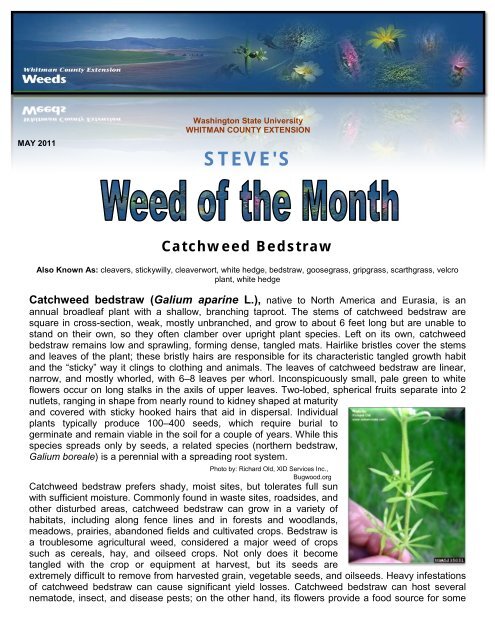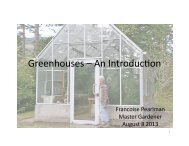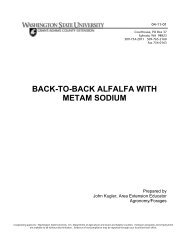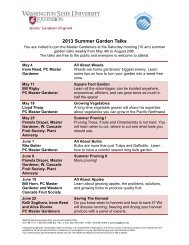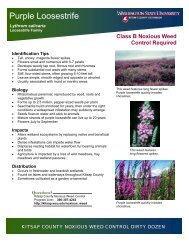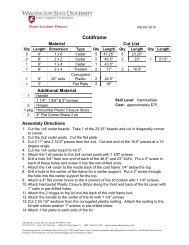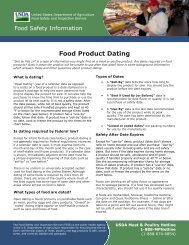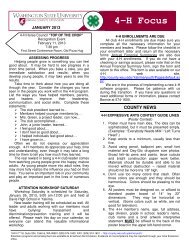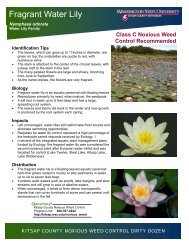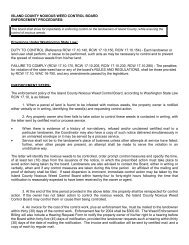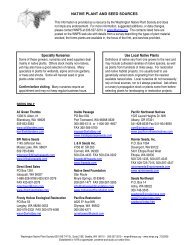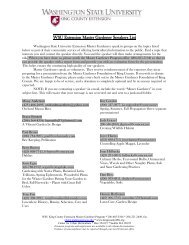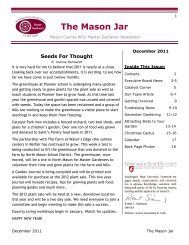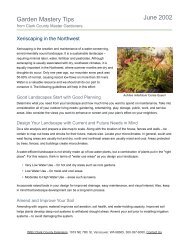Catchweed Bedstraw - WSU Extension Counties - Washington State ...
Catchweed Bedstraw - WSU Extension Counties - Washington State ...
Catchweed Bedstraw - WSU Extension Counties - Washington State ...
Create successful ePaper yourself
Turn your PDF publications into a flip-book with our unique Google optimized e-Paper software.
MAY 2011<br />
<strong>Washington</strong> <strong>State</strong> University<br />
WHITMAN COUNTY EXTENSION<br />
STEVE'S<br />
<strong>Catchweed</strong> <strong>Bedstraw</strong><br />
Also Known As: cleavers, stickywilly, cleaverwort, white hedge, bedstraw, goosegrass, gripgrass, scarthgrass, velcro<br />
plant, white hedge<br />
<strong>Catchweed</strong> bedstraw (Galium aparine L.), native to North America and Eurasia, is an<br />
annual broadleaf plant with a shallow, branching taproot. The stems of catchweed bedstraw are<br />
square in cross-section, weak, mostly unbranched, and grow to about 6 feet long but are unable to<br />
stand on their own, so they often clamber over upright plant species. Left on its own, catchweed<br />
bedstraw remains low and sprawling, forming dense, tangled mats. Hairlike bristles cover the stems<br />
and leaves of the plant; these bristly hairs are responsible for its characteristic tangled growth habit<br />
and the “sticky” way it clings to clothing and animals. The leaves of catchweed bedstraw are linear,<br />
narrow, and mostly whorled, with 6–8 leaves per whorl. Inconspicuously small, pale green to white<br />
flowers occur on long stalks in the axils of upper leaves. Two-lobed, spherical fruits separate into 2<br />
nutlets, ranging in shape from nearly round to kidney shaped at maturity<br />
and covered with sticky hooked hairs that aid in dispersal. Individual<br />
plants typically produce 100–400 seeds, which require burial to<br />
germinate and remain viable in the soil for a couple of years. While this<br />
species spreads only by seeds, a related species (northern bedstraw,<br />
Galium boreale) is a perennial with a spreading root system.<br />
Photo by: Richard Old, XID Services Inc.,<br />
Bugwood.org<br />
<strong>Catchweed</strong> bedstraw prefers shady, moist sites, but tolerates full sun<br />
with sufficient moisture. Commonly found in waste sites, roadsides, and<br />
other disturbed areas, catchweed bedstraw can grow in a variety of<br />
habitats, including along fence lines and in forests and woodlands,<br />
meadows, prairies, abandoned fields and cultivated crops. <strong>Bedstraw</strong> is<br />
a troublesome agricultural weed, considered a major weed of crops<br />
such as cereals, hay, and oilseed crops. Not only does it become<br />
tangled with the crop or equipment at harvest, but its seeds are<br />
extremely difficult to remove from harvested grain, vegetable seeds, and oilseeds. Heavy infestations<br />
of catchweed bedstraw can cause significant yield losses. <strong>Catchweed</strong> bedstraw can host several<br />
nematode, insect, and disease pests; on the other hand, its flowers provide a food source for some
eneficial insects. If ingested by animals, bedstraw forage can inflame the digestive tract or act as a<br />
diuretic. Entanglement in sheep wool reduces value.<br />
Historically used as an herbal remedy for various ailments, its dried and roasted fruits have also been<br />
used to make a coffee substitute (in fact, the plant is in the same family as coffee, Coffea spp).<br />
Photo by: Joseph Di Tomaso, University Photo by: Mary Ellen (Mel) Harte, Photo by: Joseph DiTomaso, University of<br />
of California-Davis, Bugwood.org Bugwood.org California-Davis, Bugwood.org<br />
Photo by: Utah <strong>State</strong> University Archive, Photo by: Richard Old, XID Services Inc.,<br />
Utah <strong>State</strong> University, Bugwood.org Bugwood.org<br />
Photo by: John D Byrd, Mississippi <strong>State</strong> University, Bugwood.org
CONTROL METHODS<br />
Cultural Control: In agricultural areas, growth of catchweed bedstraw can be suppressed by planting<br />
a competitive crop or ground cover, although preliminary consideration should be preventing it by<br />
eliminating contaminated crop seed, machinery, livestock, and manure. Long-term control of<br />
catchweed bedstraw relies on removing existing plants before they flower and produce viable seed.<br />
Physical/Mechanical: For small infestations, hoeing or hand-pulling can be effective, especially<br />
when soil is damp; care must be used, however, because the weak stems of bedstraw break easily<br />
making it difficult to remove the roots. Regular mowing at a low height may be an option, although<br />
cutting of the plant to 2–3 inches has been reported to actually increase biomass production up to<br />
30% compared to uncut plants. Winter annual bedstraw should be controlled in the fall after<br />
germination with tillage or an herbicide<br />
Chemical Control: Control of bedstraw is different depending on the crop it infests. Herbicide<br />
options are available in cereal crops, field peas, and herbicide tolerant canola varieties. There are no<br />
herbicides registered for control of cleavers in conventional canola. Herbicides that can be effective<br />
for the control of bedstraw (dependent upon crop) are fluroxypyr, sulfosulfuron, carfentrazone,<br />
imazamethabenz, diuron, dicamba, oxyfluorfen and glyphosate.<br />
More information can be found in the<br />
PNW Weed Management Handbook<br />
Use pesticides with care. Apply them only to plants, animals, or sites listed on the<br />
label. When mixing and applying pesticides, follow all label precautions to protect<br />
yourself and others around you. It is a violation of the law to disregard label directions.<br />
Store pesticides in their original containers and keep them out of the reach of children,<br />
pets, and livestock.<br />
Biological Control: No insects or other biological agents are available to control catchweed<br />
bedstraw. While livestock will eat the plant, it is not a nutritious food source since it produces so little<br />
biomass; moreover, germination percentages actually increase following passage of the seed through<br />
animal digestive tracts so grazing should not be allowed after seed production.<br />
Questions: contact Steve Van Vleet or phone (509) 397 - 6290


